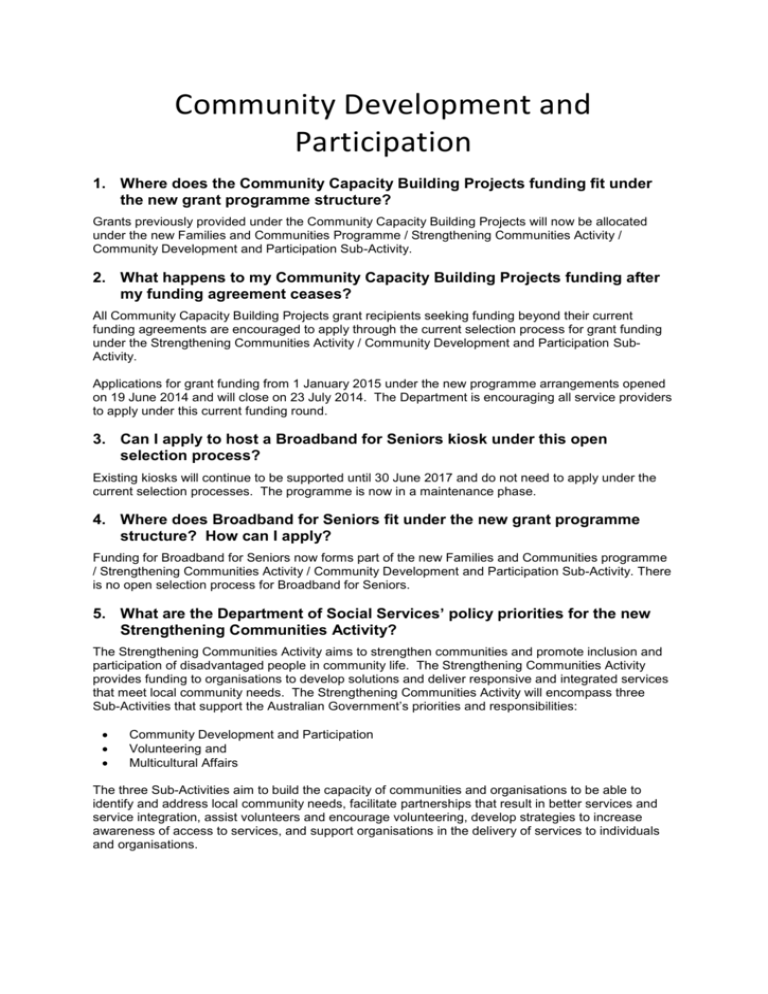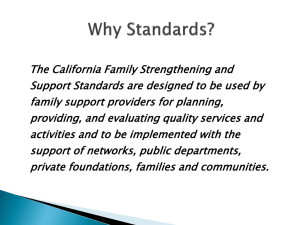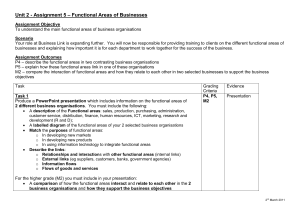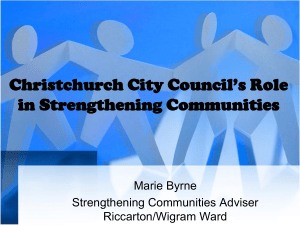SC - CD&P Q & As - Department of Social Services
advertisement

Community Development and Participation 1. Where does the Community Capacity Building Projects funding fit under the new grant programme structure? Grants previously provided under the Community Capacity Building Projects will now be allocated under the new Families and Communities Programme / Strengthening Communities Activity / Community Development and Participation Sub-Activity. 2. What happens to my Community Capacity Building Projects funding after my funding agreement ceases? All Community Capacity Building Projects grant recipients seeking funding beyond their current funding agreements are encouraged to apply through the current selection process for grant funding under the Strengthening Communities Activity / Community Development and Participation SubActivity. Applications for grant funding from 1 January 2015 under the new programme arrangements opened on 19 June 2014 and will close on 23 July 2014. The Department is encouraging all service providers to apply under this current funding round. 3. Can I apply to host a Broadband for Seniors kiosk under this open selection process? Existing kiosks will continue to be supported until 30 June 2017 and do not need to apply under the current selection processes. The programme is now in a maintenance phase. 4. Where does Broadband for Seniors fit under the new grant programme structure? How can I apply? Funding for Broadband for Seniors now forms part of the new Families and Communities programme / Strengthening Communities Activity / Community Development and Participation Sub-Activity. There is no open selection process for Broadband for Seniors. 5. What are the Department of Social Services’ policy priorities for the new Strengthening Communities Activity? The Strengthening Communities Activity aims to strengthen communities and promote inclusion and participation of disadvantaged people in community life. The Strengthening Communities Activity provides funding to organisations to develop solutions and deliver responsive and integrated services that meet local community needs. The Strengthening Communities Activity will encompass three Sub-Activities that support the Australian Government’s priorities and responsibilities: Community Development and Participation Volunteering and Multicultural Affairs The three Sub-Activities aim to build the capacity of communities and organisations to be able to identify and address local community needs, facilitate partnerships that result in better services and service integration, assist volunteers and encourage volunteering, develop strategies to increase awareness of access to services, and support organisations in the delivery of services to individuals and organisations. 6. Are the target groups for the new Community Development and Participation Sub-Activity the same as the target groups under the old Community Capacity Building Projects? The target groups of the new Community Development and Participation Sub-Activity expanded on those prioritised through the previous Community Capacity Building Projects initiative and now include: Indigenous Australians People from culturally and linguistically diverse backgrounds People with Disability People with mental health issues Individuals/communities who are vulnerable or at risk of social exclusion* *Social exclusion is usually defined as when people or areas suffer from a combination of linked problems such as unemployment, discrimination, poor skills, low income, poor housing, high crime, bad health and family breakdown. Social exclusion is therefore about more than income poverty. Socially excluded people experience multiple disadvantages which can mutually reinforce each other. These disadvantages combine to hinder their ability to participate fully in society. 7. How much grant funding will be provided through the Community Development and Participation selection exercise and how long will grants be for? In 2014-15, approximately $3.5 million will be made available for Community Development and Participation projects. In 2015-16, approximately $7 million will be available for projects. In terms of individual projects: One-off funding of up to $100,000 will be available to support time limited proposals that support a timely and cost effective investment to address a significant identified need within a community. Funding of up to $100,000 per annum, for a maximum of 3 years may also be available to support proposals for multi-year investment projects which will deliver a significant ongoing benefit to the community. (Applications should clearly outline the scope and provide a detailed budget). Selection processes for future financial years will be held at a later time. Selection assessments will consider: The location of projects/programmes being proposed The number of projects/programmes proposed in each location and The aim and purpose of each project/programme in a location and The number of services proposed in each State and Territory A higher priority will be given to proposals that provide services in areas of greatest need, in particular to individuals and/or communities experiencing disadvantage. National measures of disadvantage will be used to inform this assessment, such as the Socio-Economic Indexes for Areas (SEIFA). Applicants should ensure that responses to Selection Criteria 5 clearly address this priority. 8. Why does the Community Development and Participation Sub-Activity have a focus on one-off/time limited grants? Providing time limited grants will allow the successful applicants to engage other community and corporate partners for the ongoing delivery of their projects. It will also allow the Department to continue to provide services to other communities to address ever changing, and emerging, community needs. 9. I want to apply for funding under the new Community Development and Participation funding round. How do I write a successful application? You should align your rationale, aims and objectives to the funding guidelines and ensure that your target group is clearly identified (as per item 2.4 of the guidelines). Make sure that your rationale is clear, concise and is supported by evidence. The rationale should specify: the scale of the issue which your proposal will help to address the characteristics of the target group and unmet need in your area why meeting the target groups need is a priority how the project will make a difference for the target group links to local, state and national priorities ways in which the project will meet its objectives why the requested resources are essential to success how the project gives value for money To ensure that rationales are backed up with up to date and comprehensive evidence, applicants could reference some of the following data sources within their applications (if applicable): ABS data and/or community surveys and/or organizational evaluations and/or mapping exercises. This will ensure that the all claims are effectively substantiated. The provision of supporting letters from community or government stakeholders, clients, funding partners and so on, is also recommended to ensure that the need for the proposal is fully understood, sanctioned and personalized. Evidence of your ability to be financially viable over the long term will also be critical. This evidence could include letters from third or private sector partners highlighting their financial commitment to the project over the long term, or the provision of strategic and/or philanthropic plans which document the organisation’s long term goals in terms of raising revenue. Applicants should not only provide a robust rationale related to community need, but should also be able to show a commitment to some of the key tenets of a well-functioning ‘civil society’ by providing evidence that they: Are actively working with public, private and third sector partners and/or Have local individuals and/or representative groups involved in the planning and development of the project and/or Are able to explain how their projects are aligned with wider local plans/strategies and/or Propose projects that do not duplicate existing services or Government initiative, and/or Propose projects that have an early intervention or prevention focus and/or Are organisations that attract resources and opportunities into their community and/or Apply commercial strategies to maximise improvements in human well-being, through social enterprise type initiatives that derive a portion of their income through trade and/or Are mobilising and developing their own abilities to combat the effects of social exclusion and disadvantage and/or Are empowering individuals, families and community groups to take control of their future and/or Are transforming community systems to meet their needs (for example, transforming enabling systems to empowering systems) 10. Is a commitment to equitable access to service delivery an important part of the Community Development and Participation activity? Due to the activity’s fundamental commitment to supporting society’s most vulnerable groups, showing a commitment to equitable access to services should be included in any application. The provision of access and equity plans, as part of the application, which highlight culturally appropriate service delivery practices and principles will assist the assessment process. Applications need to show that the organisation applying for funding is engaging with the wider community to achieve inclusive and equitable practices, with a focus on how marginalized individuals can connect to services, supports, and social activities. 11. Can I include a component related to evaluation in my proposal/budget? The Department encourages the inclusion of an evaluation strategy. It is important to include a systematic and objective assessment of a program, project, initiative, service, function or activity to assist in decision making. Evaluation also provides evidence for addressing aspects of effectiveness, efficiency and appropriateness of the project. 12. What questions should I answer when drafting the application? How many people are likely to participate? Does the application target sectors of the community? Is there a clearly identified need for this application? Does the application fulfil this need? Has the application appropriately engaged with the local community? Have local people, participants, members or service users been involved in identifying this need and have input into the response? Does the application target a particular sector of the community? Is the application accessible and inclusive? Does the application address issues of disadvantage? Does the application identify appropriate partners that they will work with in a collaborative way?



